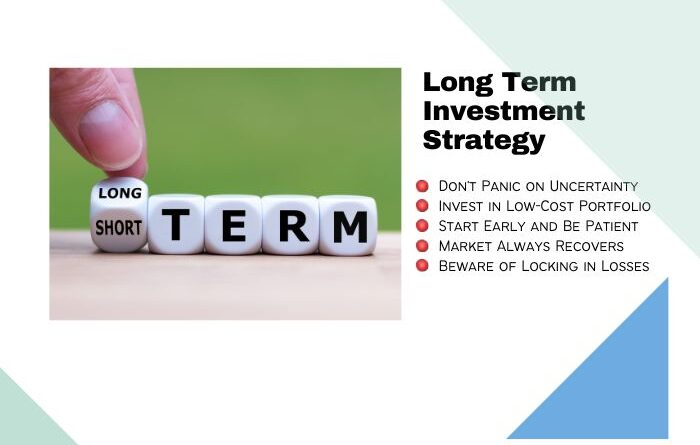Long-term investment strategies involve planning for the future by making smart financial decisions now. With a focus on stability and growth, these strategies are crucial for building wealth over time.
Exploring different types of strategies, portfolio diversification, and performance evaluation, this guide will provide you with the essential knowledge to make informed investment decisions.
Introduction to Long-term Investment Strategies

Long-term investment strategies refer to a method of investing with a focus on achieving financial goals over an extended period, typically five years or more. These strategies involve holding onto assets for a significant period, allowing them to grow and accumulate value over time.
Having a long-term approach to investing is crucial for building wealth and achieving financial stability. It allows investors to ride out market fluctuations and benefit from the power of compounding returns. By staying invested for the long haul, investors can potentially earn higher returns compared to short-term trading.
When comparing short-term versus long-term investment strategies, it’s important to note that short-term strategies involve buying and selling assets within a short period, often based on market trends or price fluctuations. On the other hand, long-term strategies focus on holding onto investments for an extended period, regardless of short-term market movements.
Successful long-term investment strategies often involve diversification, regular contributions, and a focus on high-quality assets with strong growth potential. Examples include investing in a diversified portfolio of stocks, bonds, and real estate, and consistently adding to investments over time to take advantage of compound growth.
Types of Long-term Investment Strategies
When it comes to long-term investment strategies, there are several approaches that investors can consider based on their financial goals and risk tolerance. Each type of strategy comes with its own risk-return profile and suitability for different investors.
Buy and Hold Strategy
The buy and hold strategy involves purchasing securities and holding onto them for an extended period, regardless of short-term market fluctuations. This strategy is often associated with lower transaction costs and less frequent trading. Investors who adopt this strategy typically believe in the long-term growth potential of their investments. While this strategy may offer potential for significant gains over time, it also carries the risk of market downturns affecting the overall portfolio value.
Dollar-Cost Averaging
Dollar-cost averaging is a strategy where investors regularly invest a fixed amount of money at scheduled intervals, regardless of market conditions. This approach can help mitigate the impact of market volatility by spreading out the investment over time. While dollar-cost averaging may reduce the risk of making poor investment decisions based on market timing, it may also limit the potential for significant gains during periods of market growth.
Value Investing
Value investing involves identifying undervalued securities that have the potential for long-term growth. This strategy focuses on buying assets that are trading below their intrinsic value, with the expectation that their value will increase over time. Value investors often conduct thorough research and analysis to uncover opportunities that others may have overlooked. While value investing can offer the potential for substantial returns, it also carries the risk of misjudging the true value of an asset or industry trends.
Each of these long-term investment strategies has its own risk-return profile, and the suitability of each strategy depends on an investor’s risk tolerance and financial goals. It’s essential for investors to carefully consider their individual circumstances before choosing a strategy that aligns with their investment objectives.
Building a Diversified Portfolio for Long-term Investments

Portfolio diversification is a strategy where an investor spreads their investments across different asset classes to reduce risk and increase the chances of achieving long-term financial goals. By diversifying, investors can minimize the impact of market fluctuations on their overall portfolio performance.
Benefits of Diversifying Investments Across Asset Classes
Diversifying investments across asset classes has several benefits, including:
- Reduced Risk: By investing in a mix of assets such as stocks, bonds, real estate, and commodities, investors can lower the risk of significant losses due to the performance of a single asset class.
- Enhanced Returns: Diversification can potentially lead to higher returns by capturing the performance of different asset classes that may outperform others in varying market conditions.
- Stability: A diversified portfolio is more likely to withstand market volatility and economic downturns, providing stability and a buffer against sudden market changes.
- Opportunity for Growth: Investing in a variety of asset classes allows investors to take advantage of growth opportunities in different sectors and regions, optimizing the potential for long-term growth.
Asset Allocation to Create a Diversified Portfolio
Asset allocation is the process of dividing investments among different asset classes based on an investor’s risk tolerance, financial goals, and time horizon. Examples of how asset allocation can be used to create a diversified portfolio include:
- Equities: Allocating a percentage of the portfolio to stocks for growth potential.
- Bonds: Including bonds in the portfolio for income generation and stability.
- Real Estate: Investing in real estate assets to diversify beyond traditional stocks and bonds.
- Commodities: Adding commodities like gold or oil to hedge against inflation or market volatility.
Role of Rebalancing in Maintaining Portfolio Diversification
Rebalancing is the process of adjusting the portfolio’s asset allocation back to its original target percentages to maintain diversification over the long term. This involves selling assets that have performed well and buying more of those that have underperformed to bring the portfolio back into balance. Regular rebalancing ensures that the portfolio remains aligned with the investor’s risk profile and investment objectives, helping to manage risk and optimize returns.
Evaluating Performance of Long-term Investment Strategies
When it comes to evaluating the performance of long-term investment strategies, it is essential to have a clear understanding of how to measure success and identify key performance indicators (KPIs) that can help in assessing the effectiveness of the strategy.
Measuring Performance of Long-term Investment Strategies
- One common method to measure the performance of long-term investment strategies is to calculate the overall return on investment (ROI) over a specific period. This can give a clear indication of how well the strategy has performed in generating profits.
- Another important metric to consider is the compound annual growth rate (CAGR), which provides a more accurate representation of the investment’s performance over time, taking into account the effects of compounding.
- Tracking the volatility of the investment through metrics such as standard deviation can also help in evaluating the risk associated with the strategy and its impact on overall performance.
Key Performance Indicators for Long-term Investment Strategies
- Sharpe Ratio: This KPI helps in assessing the risk-adjusted return of an investment strategy, taking into account the level of risk assumed to achieve the returns.
- Maximum Drawdown: This metric measures the largest peak-to-trough decline experienced by the investment during a specific period, providing insights into the strategy’s risk tolerance and potential losses.
- Tracking Error: This indicator compares the performance of the investment strategy against a benchmark index, highlighting the deviations and tracking accuracy of the strategy.
Tools and Methods for Performance Analysis
- Performance Attribution Analysis: This method helps in identifying the sources of returns within an investment portfolio, allowing investors to assess the effectiveness of each component in generating profits.
- Portfolio Management Software: Utilizing specialized software can streamline the tracking and analysis of long-term investments, providing detailed reports and insights into the performance of the strategy.
Comparing Approaches to Evaluating Performance, Long-term investment strategies
- Benchmarking: This approach involves comparing the performance of the investment strategy against a predefined benchmark index, providing a standardized measure to evaluate success.
- Risk-adjusted Returns: By considering the level of risk taken to achieve returns, investors can assess the efficiency of the strategy in generating profits relative to the amount of risk assumed.
In conclusion, adopting long-term investment strategies is key to securing your financial future. By implementing diversified portfolios and monitoring performance effectively, you can set yourself up for long-term success in the world of investing.


